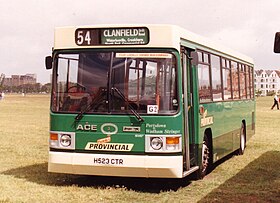This is an old revision of this page, as edited by Qqflatron (talk | contribs) at 21:37, 15 December 2013. The present address (URL) is a permanent link to this revision, which may differ significantly from the current revision.
Revision as of 21:37, 15 December 2013 by Qqflatron (talk | contribs)(diff) ← Previous revision | Latest revision (diff) | Newer revision → (diff) This article is about the type of bus. For the ship, see MV Cougar Ace. Motor vehicle| ACE Cougar | |
|---|---|
 The first ACE Cougar, Provincial's 3, at the Southsea Bus Rally in June 1991. The first ACE Cougar, Provincial's 3, at the Southsea Bus Rally in June 1991. | |
| Overview | |
| Manufacturer | Alternative Chassis Engineering |
| Body and chassis | |
| Doors | 1 door |
| Floor type | Step entrance |
| Powertrain | |
| Engine | Perkins |
| Transmission | Allison |
| Dimensions | |
| Length | 10.5m |
ACE Cougar is a type of bus built by Alternative Chassis Engineering in the UK in the early 1990s. It did not prove successful and only two were built.
Details
The ACE Cougar was designed to use Leyland National components wherever this was possible. The chassis was powered by a rear 'in-line' mounted Perkins 6-cylinder 'Phaser' turbo engine, and included Allison automatic transmission and air suspension. Both models built were 10.5m long and 2.3m wide.
Production and operations

The Cougar was built in ACE's factory in Huddersfield and entered production in late 1989. The first Cougar was bodied by Wadham Stringer and sold to People's Provincial in 1990. Provincial director James Freeman saw the vehicle as a possible replacement for the company's large fleet of Leyland Nationals, but in the event only one was delivered. It was the only full-size bus bought new by Provincial as an independent company following privatisation in 1987. Provincial was taken over by First Group in 1995; the Cougar was used by the First Hampshire & Dorset subsidiary until 2004, and is now preserved.
The second carried Willowbrook Warrior bodywork (a body rarely applied to new vehicles). It was completed in 1991 and was initially painted in a demonstrator livery, but was sold to West Midlands independent Caves Bus Services later in the year. Caves closed down in June 1999 and the Cougar was sold to a private owner on Valentia Island.
Intended developments
Both Cougars built were technically described as ACE Cougar V models. This was to differentiate them from the Cougar VI, a 12m variant which ACE intended to build for sale to London Buses. ACE director Keith Ward suggested that up to 100 Cougar Vs and Cougar VIs could be built per year. The company also intended to create 30 manufacturing jobs producing the vehicles. However, ACE went out of business in late 1991, having produced no further vehicles of any sort.
See Also
References
- ^ Provincial Society - Survivors
- ^ "Cougar ready to go". Buses (433): 151. April 1991.
- Booth, Gavin (Autumn 1994). "Bus Scene: Single-dekers". Buses Focus: 24.
- ^ Bus Lists on the Web: ACE
- Brown, Stewart J (November 1995). Buses in Britain 2: The Mid Nineties. Capital Transport. p. 175. ISBN 1-85414-181-3.
- Preserved Provincial Buses - Gosport and Fareham Omnibus Company (Provincial)
- ^ Caves Bus Services reddibus.co.uk
- "Caves' Cougar". Buses (585). December 2003.
- ^ "Expocoach". Buses (430): 19. January 1991.
External links
- Provincial Society: restoring the first ACE Cougar
- A flickr page discussing the history of the second ACE Cougar